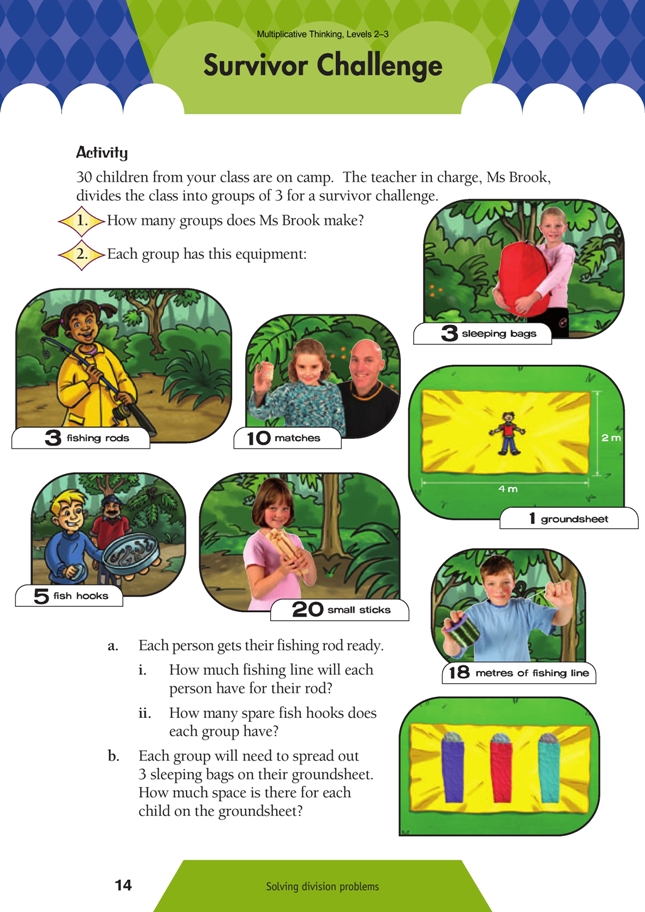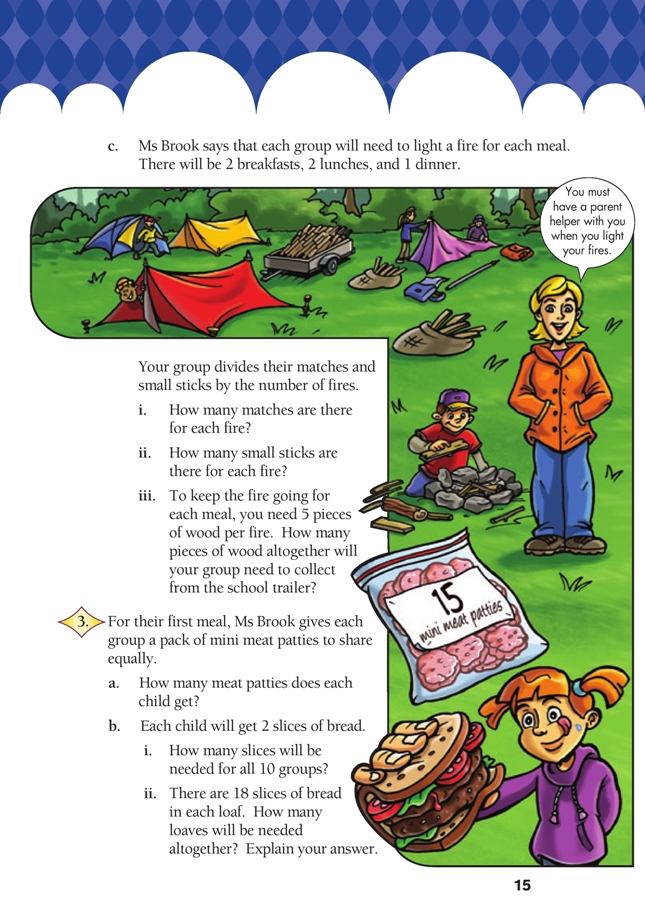This is a level 3 number activity from the Figure It Out series. It relates to Stage 6 of the Number Framework.
A PDF of the student activity is included.
Click on the image to enlarge it. Click again to close. Download PDF (854 KB)
solve division problems by using multiplication facts
Number Framework Links
This activity is suitable for group instruction at stage 5. Some of the questions will challenge students at stage 4 in terms of the strategies they might think of using, but that may make it a worthwhile activity for seeing how these students cope with problems involving fractions and continuous models for division. Students at stage 6 could attempt this independently and bring it to a group session for discussion.
FIO, Levels 2-3, Multiplicative Thinking, Survivor Challenge, pages 14-15
This activity presents simple multiplication and division problems in a variety of ways. It provides a context for students to use and share their strategies. You could also use it for getting assessment information through observation.
Some of the objects to be shared are discrete items, such as sticks and fish hooks. Others are continuous, such as fishing line and groundsheets. This provides students with the opportunity to solve different types of divisions. Dividing something like a long string into pieces is different from sharing out items like sticks. With the items, you can see the things to be shared and can keep giving them out until they are gone. With the string, you can’t see the “bits”; they have to be formed by splitting the length into equal pieces.
Encourage the students to use known facts to solve question 1. They could then move from 3 x = 30 to exploring 30 ÷ 3 = 10. If necessary, you could link this to 10 + 10 + 10 = 30 to make it clearer.
Parts a and b of question 2 involve the continuous model. In 2a i, the fishing line is continuous. If the students need help with solving this problem, you could use a number line or a measuring tape to represent the fishing line so that the students can visualise dividing it into segments. Similarly, in 2 a ii, the groundsheet problem involves dividing a continuous length. The numbers here are also tricky because the answer involves a fraction. This further emphasises the continuous model. When sharing objects, we end up with some “left over” (such as in the fish-hook question)
rather than dividing into fractional parts. In the case of the groundsheet, the whole groundsheet is used rather than bits being chopped off, so the students have to work out that each person will get 1 metre and a share of the leftover metre. The other difficulty with this problem is that the groundsheet is an oblong, with two dimensions. Discuss this with the students and agree on dividing the 4 metre length to find out how much space each child would get. You could extend this problem by measuring some of your students and seeing how much space they take up in two dimensions – how big an oblong they would occupy. The students could then explore other ways
to fit 3 people on the groundsheet. A powerful illustration of this would be to use centimetres for measuring the students and then convert the groundsheet dimensions into centimetres as well.
Question 2c reverts to discrete items. The students should realise, from 2 + 2 + 1, that they need to use their 5 times table.
The meat patties in question 3 are discrete objects to be shared among the group. Encourage the students to try to use what they know to solve the problem in a rather than modelling the sharing. The next two problems (b i and ii) use the same context to pose multiplication problems. Although addition and subtraction can be used, encourage the students to think multiplicatively. The numbers are useful for encouraging students to use doubling strategies or tidy numbers. You could use this
question to discuss remainders with the students: What might Ms Brook do with the leftover slices of bread? Students who are beginning to think proportionally could consider what fraction of a loaf is left.
Answers to Activities
1. 10 groups. (3 x = 30; 30 ÷ 3 = 10)
2. a. i. 6 m. (18 ÷ 3 = 6; 3 x = 18)
ii. 2. (5 – 3 = 2)
b. 1.3 m or 1 m. (4 m is 1 m each and 1 m left over to share: 1 ÷ 3 = each)
c. i. 2. (There will be 2 + 2 + 1 = 5 fires altogether. 10 ÷ 5 = 2)
ii. 4. (20 ÷ 5 = 4)
iii. 25. (5 x 5 = 25)
3. a. 5. (15 ÷ 3 = 5)
b. i. 60. (3 x 2 = 6 slices per group. 6 x 10 groups = 60 slices)
ii. 4 loaves. 18 x 2 = 36, 36 x 2 = 72 slices. 72 – 60 = 12. So 4 loaves are needed,
with 12 slices left over. Or: 18 is close to 20. 20 x 3 = 60, which is enough for
the 10 groups, but that’s counting 2 slices per loaf that aren’t there, so an
extra loaf is needed. 20 x 4 = 80. 80 – 6 = 72 (that is, minus the 6 “tidy number” slices), 72 – 60 = 12 spare slices.

